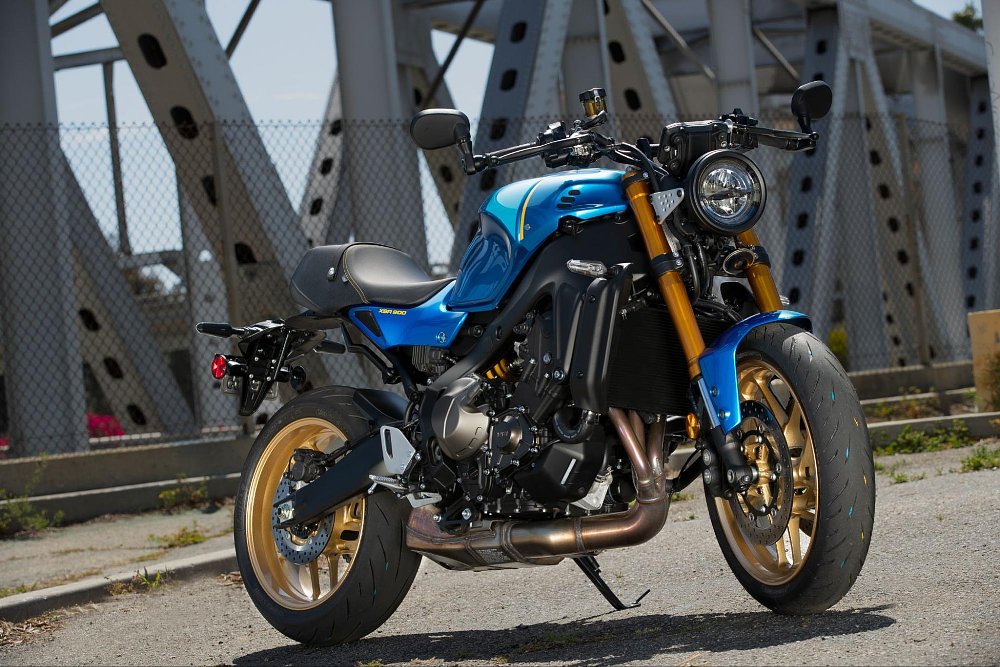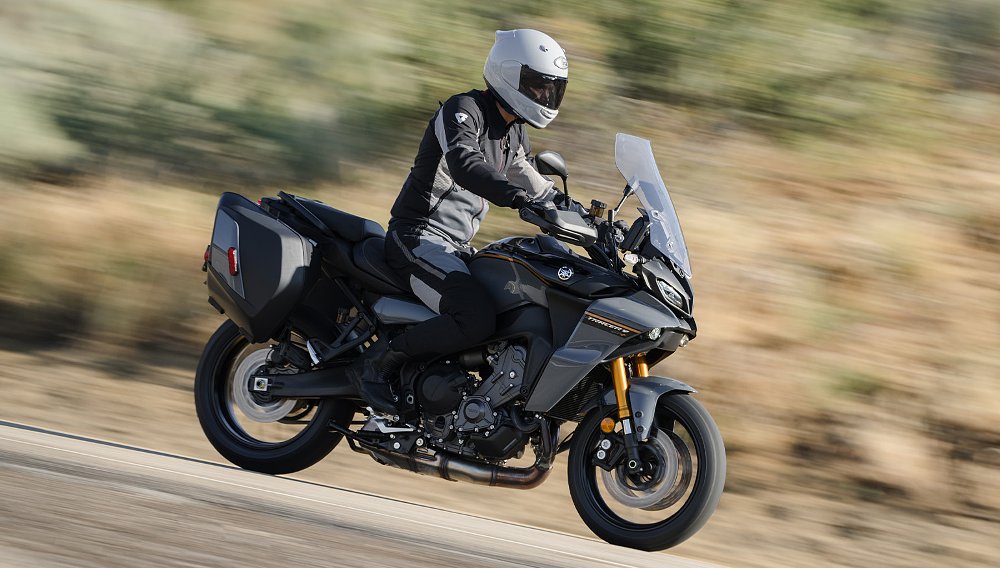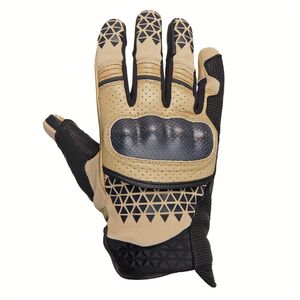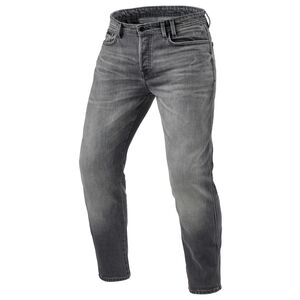WHAWRR! Bang! Second gear. WHAWRR! Bang! Third gear. WHAWRRR!!
The front tire skims over the pavement. The grips shake like a bobblehead. I’m coming up on traffic — and fast. I blast between a Tesla and a Tacoma; the gap’s just big enough for the bike and me (and whichever angel is sitting pillion). I’m riding like a grade-A arse hat. I’m riding like the kind of rider I detest. I’m riding the 2024 Yamaha MT-09.
Yamaha’s hypernaked has a reputation that precedes it. Debuting stateside as the FZ-09 in 2014, the MT-09 has undergone several makeovers in the past decade. Four to be exact. And throughout those regularly scheduled refreshes, the model has maintained a hooligan’s edge. That doesn’t mean the MT doesn’t benefit from Yamaha’s latest reformative efforts.
While the CP3 inline triple and lightweight aluminum frame remain the stars of the show, it’s the supporting cast that elevates this production. From new styling to revised ergos, from updated tech to a reworked chassis, a series of minor changes not only refine the bike’s ride, but also its image.
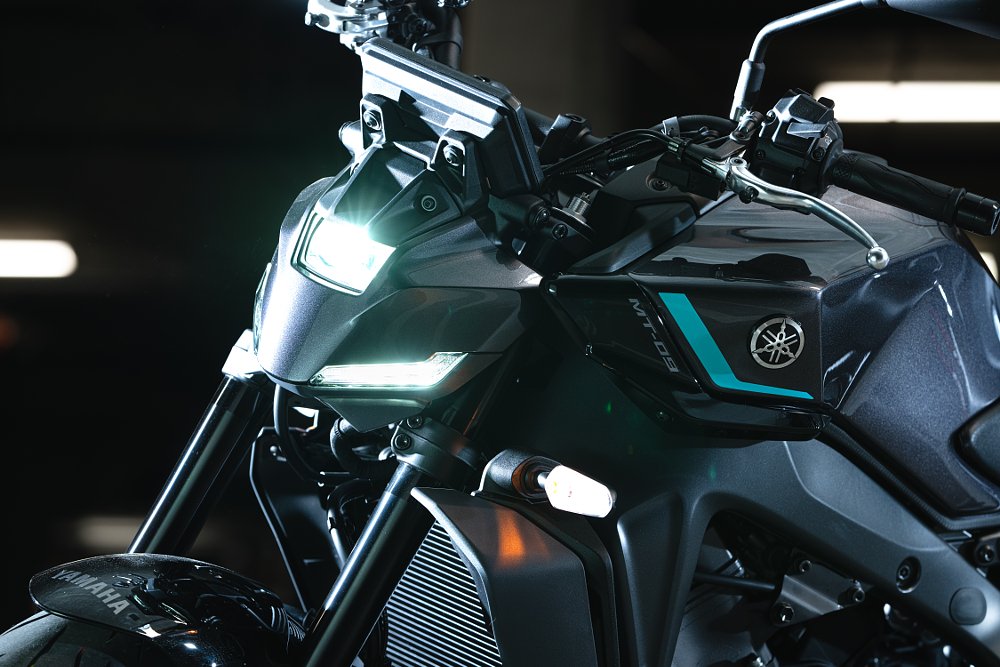
You new around here?
The MT-09 was never the prettiest in the parking lot. Sure, it won Red Dot Design Awards in 2014 and 2021, but few motorcyclists would crown it a curbside beauty queen. The model’s outward appearance always matched its inner attitude, though. Gnarly on the outside, gnarly on the inside, like a can of Monster Energy. The latest 09 leans closer to a Red Bull. Tasteful exterior, combustible contents. Same kick, new can.
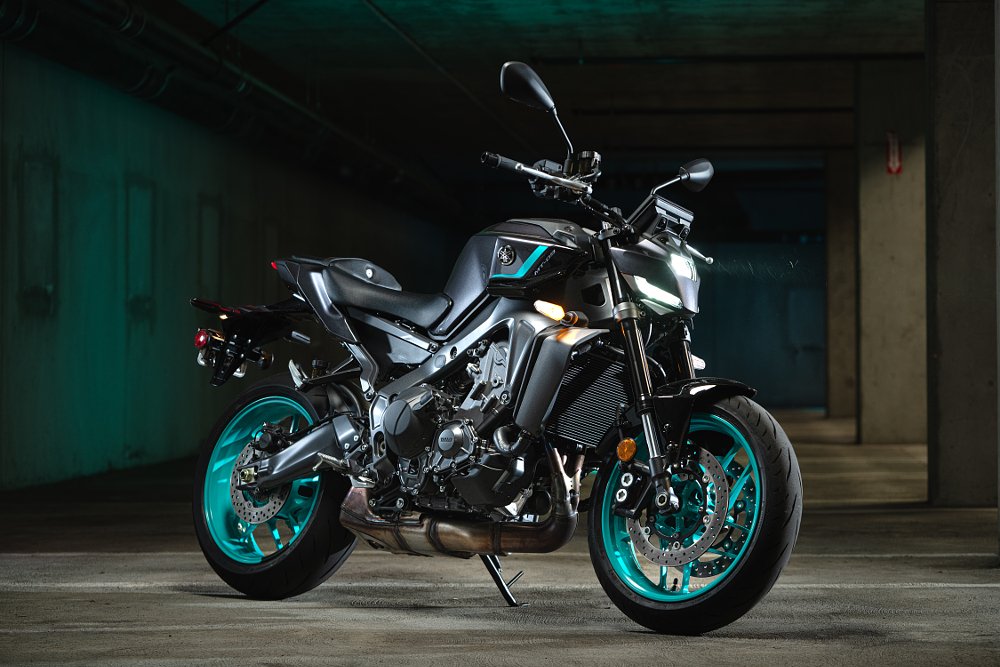
This time around, Yamaha designers sanded down the MT’s jagged edges, yet its bodywork is sharper than ever. The gas tank is chiseled and angular, with air scoops integrated into its broad shoulders. The headlight assembly earns a facelift, too. Whereas the old unit looked like the love child of a Decepticon and Kamen Rider, the new nacelle mimics Iron Man’s mask, especially with its two underslung LED lamps.
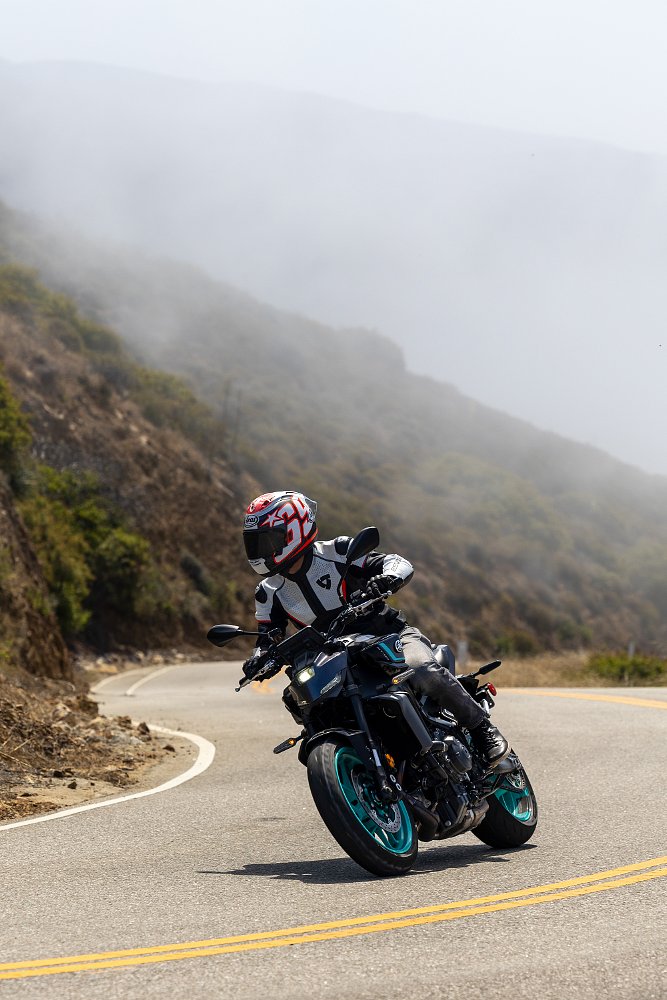
The 09’s pursuits only follow that sporty new form. Yamaha set out to improve the model’s front-end feel. The solution? Position the rider further forward, over the front wheel. The handlebar is 1.4 inches lower. The foot pegs are 0.4 inches higher and 1.2 inches further aft. Despite the shift in riding position, the MT never verges on uncomfortable. Not by a long shot. With 3.3 degrees of rearward sweep, the bar still promotes a nearly upright posture. Legroom is no different, abundant for most riders and sufficient for the inseam-gifted.
Even at highway speeds, my complaints were minimal. As nakeds go, wind protection is practically non-existent. Models with more neutral ergos only amplify that quality. That’s the case with the MT-09, and somehow, wind buffeting rarely plays a factor. Is it the way the rider sits in the bike, not on it? Is it the new handlebar position? Is it how my torso and shoulders also bear the brunt of the wind, not just my head? I won’t pretend to know for sure. I just know the MT remains comfortable in almost every way. Almost.
For the first time in its history, the MT-09 comes with a two-piece seat. Yamaha claims the separate perches enhance both pilot and passenger comfort but I beg to differ. Past MT-09 seats contoured to the rider’s rear end like a tailbone pillow. Those days are long gone. The current unit takes a Spartan approach, which isn’t bothersome when tearing through town or carving through curves, but spend any considerable time on the highway, and the MT is anything but the lap of luxury. The same could be said for the bike’s vibrations.
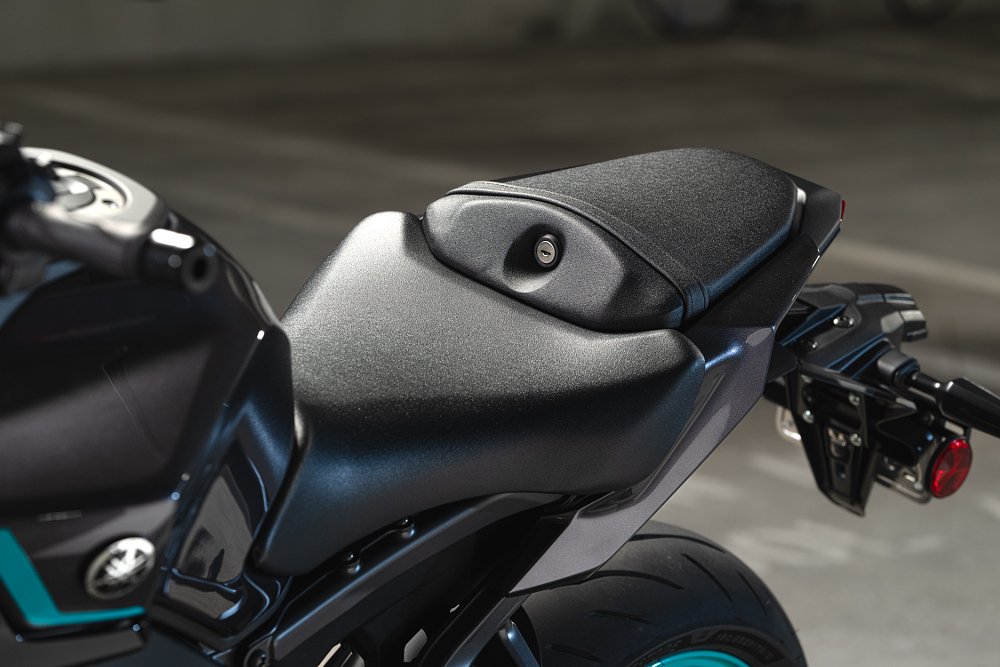
There’s a fine line between good vibes and bad vibes (so my spiritual coach tells me). Some vibration is welcome. It enlivens the experience, as long as it doesn’t overstay its welcome. That’s, sadly, the case with the MT’s footpegs. Tug on the throttle and the bike bursts ahead, buzzing all the while. But when that rush of acceleration subsides, the vibes linger, like a guest who won’t take a hint. (Hey, uh, that was fun and all, but don’t you have anywhere to be?)
The vibes are less prominent from takeoff but still evident. They’re present by 4,000 rpm, persist at the 6k mark, and peak at eight grand. They aren't exclusive to the footpegs, either. The handlebar and mirrors join the party around 5,500 rpm. I should note that I never hopped off the Oh-Nine with tingly toes or numb knuckles. That’s to say, it isn’t a dealbreaker, especially when those vibes are a byproduct of the well loved CP3 engine.
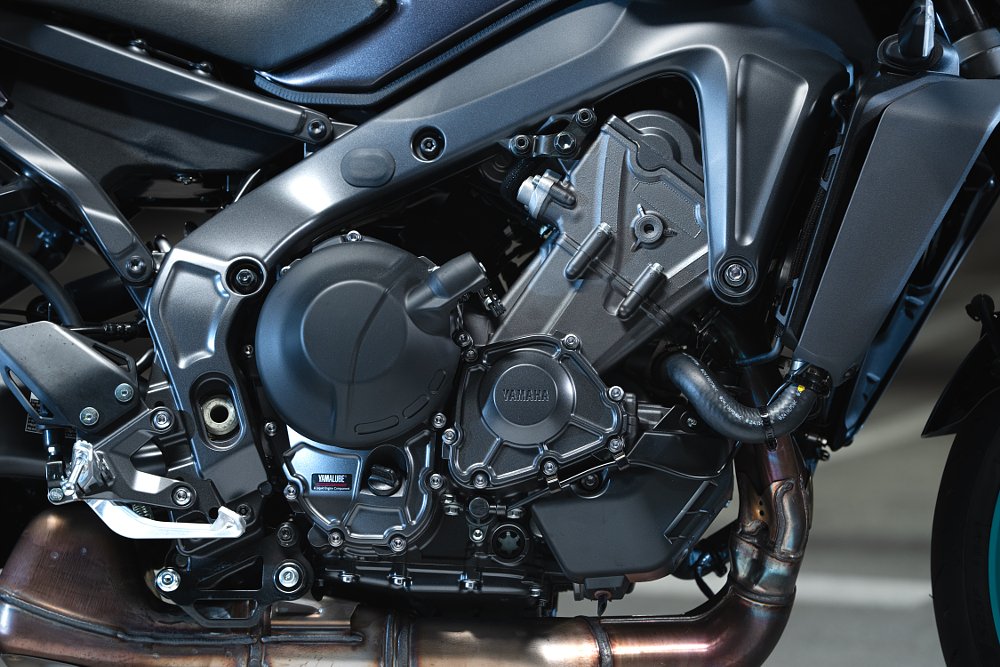
Rev’d up
What praise hasn’t been heaped on Yamaha’s inline triple by now? It’s a hoot and a half. It’s a bag of giggles. It’s some other superlative that I can’t find right now. That doesn’t mean it’s beyond improvement. In 2021, the Iwata factory revamped the three-cylinder sensation with new con rods, pistons, and cams. The stroke increased from 59.1 mm to 62.1 mm, pushing the displacement from 847 cc to 890 cc. Yamaha made no further changes this year. Well, at least not directly.
Like all new bikes, the MT-09 has to contend with today’s stringent noise emissions standards. Seldom do those noise limits align with the customer’s expectations. To satisfy both parties, the MT’s new intake system directs more induction sound into the cockpit. Air enters through the side scoops at the tank shoulders and into the airbox’s two-duct airbox. Along the way, intake sound channels to the rider through the new Acoustic Amplifier Grilles. Or so Yamaha claims. Without a back-to-back comparison with the outgoing model, it’s difficult to tell the difference.
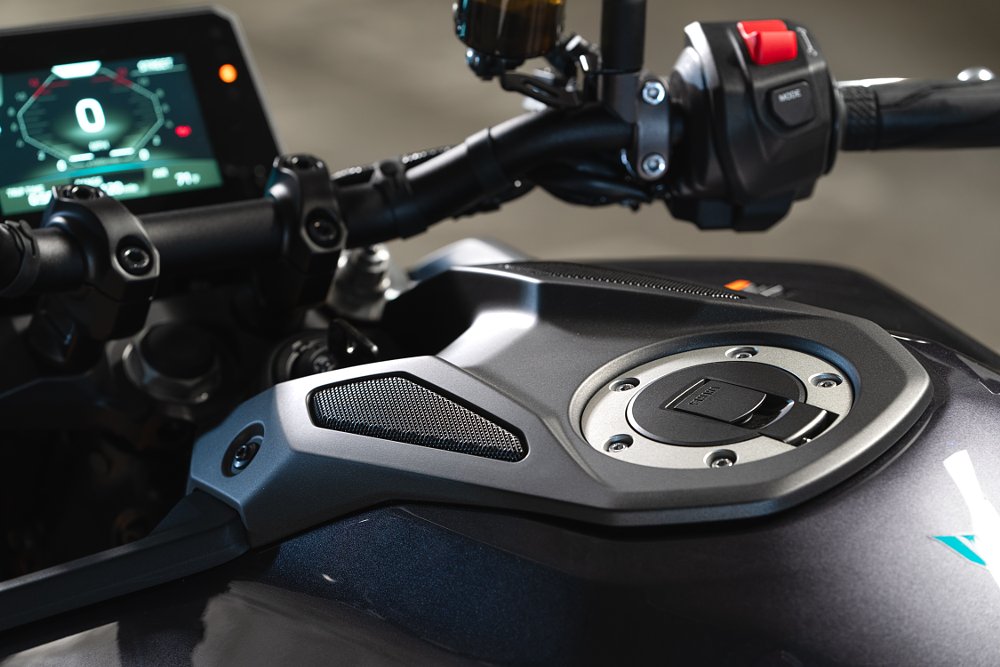
The effect is much more apparent on the MT-10, which earned a similar system in 2022. Accelerate anywhere above the 7,000-rpm mark and the grilles expel an audible WOMP. The same isn’t true of the MT-09. That’s not to say that the 09’s grilles don’t work. The bike still whistles a sweet, triple-pipe tune. It’s just not as bombastic as its bigger sibling.
Yamaha also showers the MT’s transmission and quickshifter with attention, but the effects are much more apparent. With the exception of upshifting between first and second at neutral throttle, all gear changes are prompt and smooth. The new system also allows riders to drop a gear while on the gas or upshift during deceleration. Nifty tricks when getting out of Dodge or braking downhill, respectively.
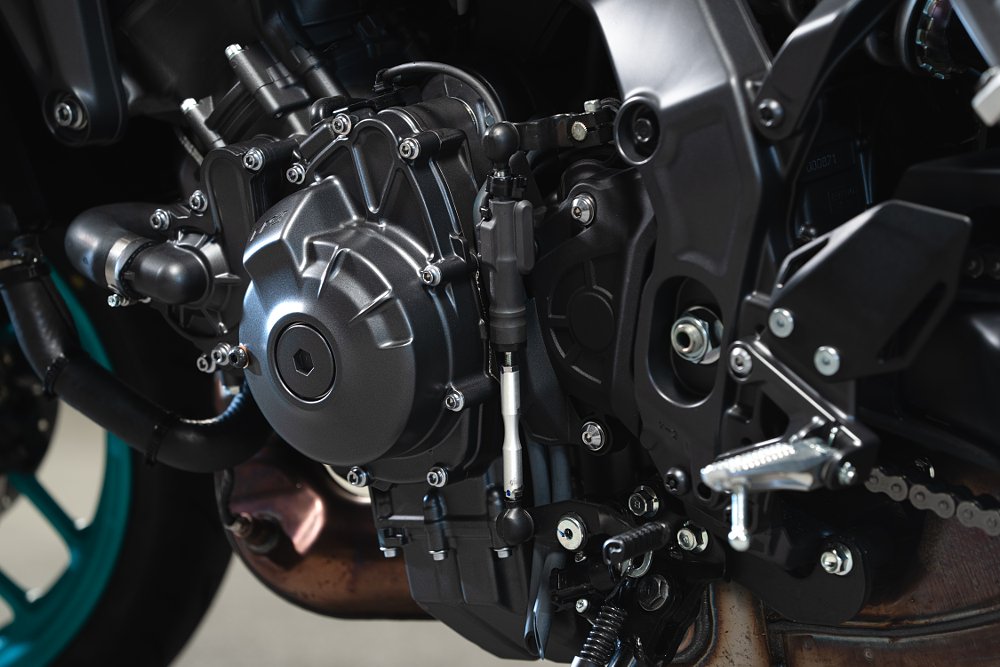
The MT-09 owes much of its hooligan repute to its CP3 engine. At the peak of its powers, the rowdy triple pulls like a spurred horse. A big wack of the throttle sends it full speed ahead or rearing up on its haunches. It’s that character that delivers on the Master of Torque moniker, and what MT-09 fans have come to expect over the years. That’s mostly true in 2024, except for the massive flat spot in second gear.
Let’s set the scene. I roll off the throttle, grab the brakes, and tip into a hairpin. The apex approaches. I look through the exit and get on the gas — but there’s no drive. No riotous WHAWRR! The throttle is pinned. Yet, the MT is draggin’ ass. Once the rev counter crawls back up to 6,000 rpm, it’s back to its normal self, rushing up to its 10,500-rpm redline.
Weird, I muse. What’s weirder is that I can’t consistently replicate the issue.
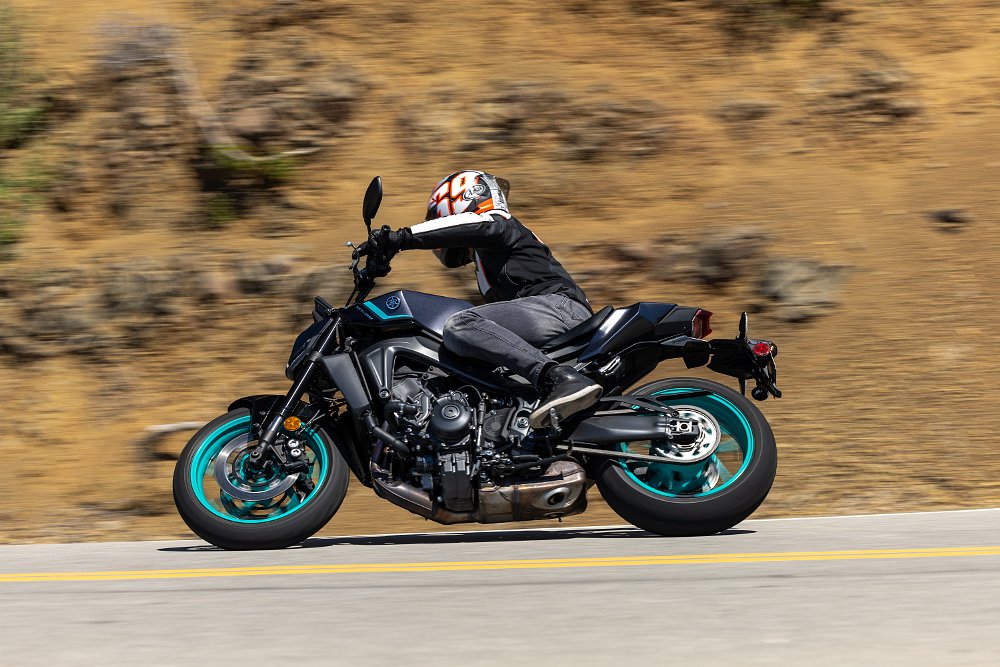
Why does it happen in this corner but not in that corner? How come it feels like quicksand now and changed like quicksilver then? I’m mystified. So much so that I enlist the help of one Ari Henning. A trip to the gas station later and he’s just as baffled. As Ari puts it, “You ask for 100% and it says, ‘mmmm, how about 60% until 5,500 rpm?’” I’m not crazy, after all. Additional testing alongside a first-gen XSR900 (belonging to CTXP camera operator Andrew Gerety) only supports our suspicions. Yeah, something’s up.
So, I reach out to Yamaha Motor U.S.A. for an explanation. After a 10-minute phone call, one thing is clear. Team Blue isn’t aware of any issues. Or at least they’re not acknowledging one. There are now more questions than answers. Could it be the traction control? Is the ECU to blame? Maybe it’s the throttle plates? The only agreement we reach is that more testing is needed and that Zack (Courts, that is) should be the one to do it. It takes one commute home for Z-Money to conclude that something’s “wrong with the fueling in second gear.” I’m doubly vindicated. Yay. But I still don’t have an explanation. Back to Yamaha, I go.
Another email exchange with the brand and I’m nowhere closer to an answer. Only after speaking to a close friend, do I learn that this issue dates back to the 2021-2023 model and is well known within the MT-09 community. There are threads on fz09.org and mt09.motorcycle-talk.com. Entire subreddits are dedicated to the topic. My friend also alerts me to Washington-based tuner, David “Vcyclenut” Verdecchia, and his YouTube videos. One of which dives into the 2024 MT-09’s ECU data.
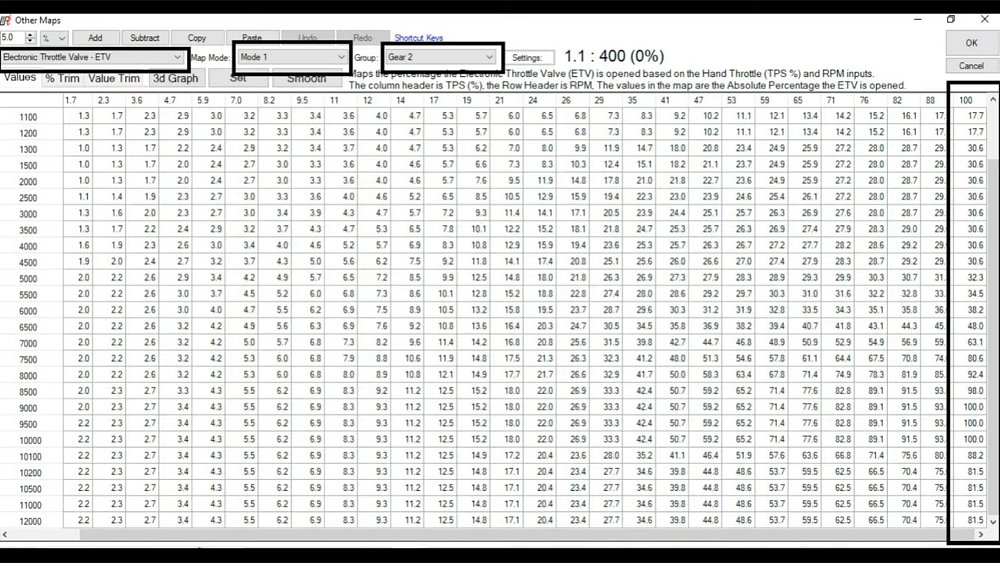
At the 2:22 mark in the video, Verdecchia presents a second-gear throttle table, which records the electronic throttle valve (ETV) opening at a given throttle position (top row) and rpm (far left column). We’re most interested in the far right column, which lists EVT values at 100% throttle. Between 1,300 and 4,000 rpm the valves only open to 30.6% of capacity. It jumps to 38.2% by 6,000 rpm and shoots up to 98% by 8,500 rpm. Only by 9,000 rpm are both the throttle and throttle valves 100% open.
The issue is just as evident when examining the dyno chart. In a separate video, Verdecchia lays out the power curves for gears two through six on a single graph. Second gear’s red line clearly stands out within the lineup, like a roller coaster among mountains. No wonder the sensation is so pronounced. Nearly a week’s worth of investigative work finally pays off, but it’s still important to put the issue into perspective.
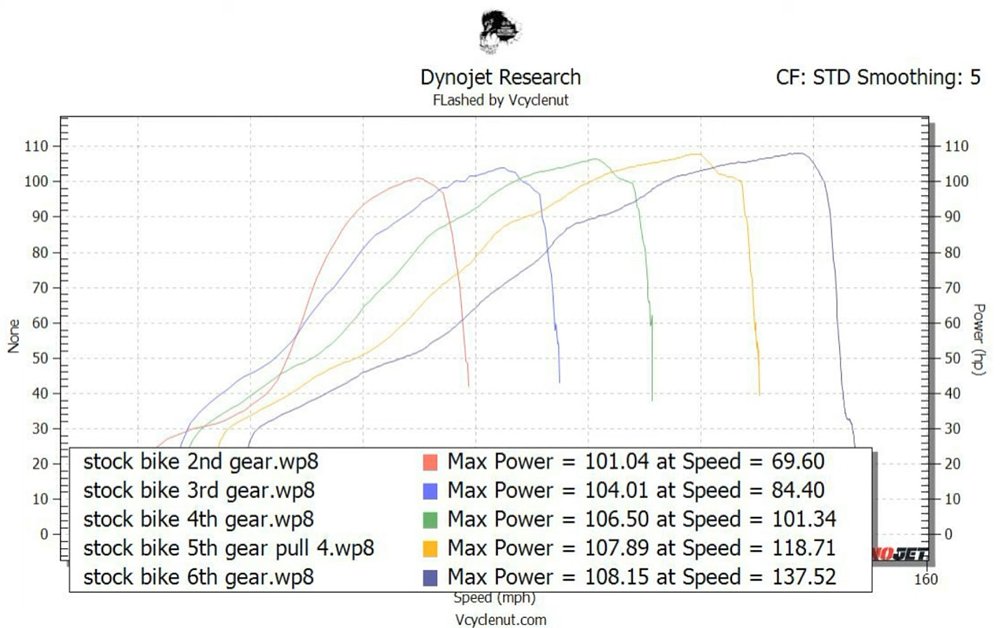
For me, the second-gear flat spot only became problematic in specific situations. That’s because upshifting out of first frequently landed me between 5,000 and 7,000 rpm (in second gear), skipping over much of the low-end doldrum. Not everyone rides that way, though. Zack often short-shifted from first to second, which exposed the hole in the powerband. All that’s to say the second-gear flat zone is avoidable, but with it covering nearly half of the rev range, it’s an unfortunate obstacle.
It’s worth noting that much of the engine mapping remains unchanged from the previous-gen MT-09. Both Zack and I tested the heavily revised 2021 model. He, the base trim. Me, the SP. Neither of us noticed the second-gear flat spot then. We can’t say the same of the MT-09 now. For the large part, the CP3 is still an engaging platform. Just don’t expect it to deliver that same engaging experience in every gear.
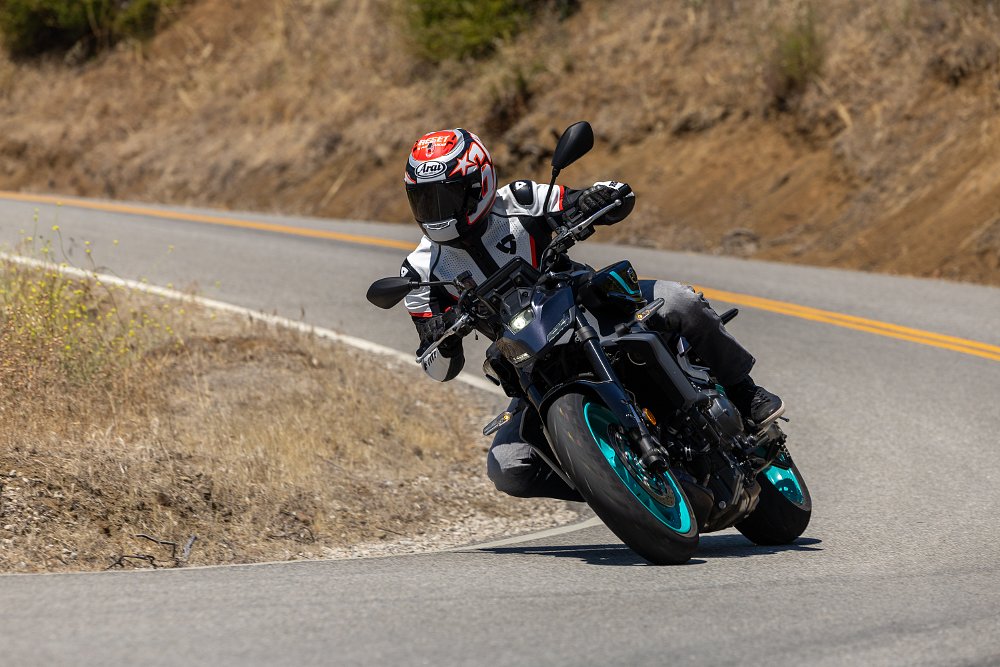
Going steady
Customers and critics often revere the MT-09 for its agility; less so for its stability. To help steady the ship, Yamaha installed thicker engine mounting brackets and a lighter headstock bracket. The former increases rigidity while the latter decreases rigidity. According to the brand, this unique blend of give and take results in better straight-line and cornering stability over a greater range of speeds — and I believe them. In 2024 form, the front end is more planted and less twitchy. Hitting a bump at high speed while leaned over still induces a headshake, but it’s less violent and quicker to recover. The revised suspension probably has something to do with that, too.
The model retains its 41 mm KYB inverted fork in 2024 but a higher spring rate (up from 14 N/mm to 15 N/mm) alters its damping characteristics. The same goes for the KYB shock, whose new linkage ratio yields a flatter damping curve. MT-09 fans, fear not. The hypernaked still pendulums through the zig-zags with the efficiency of a metronome. Although, it’s in the braking zone and corner exit where the new suspenders make a difference.
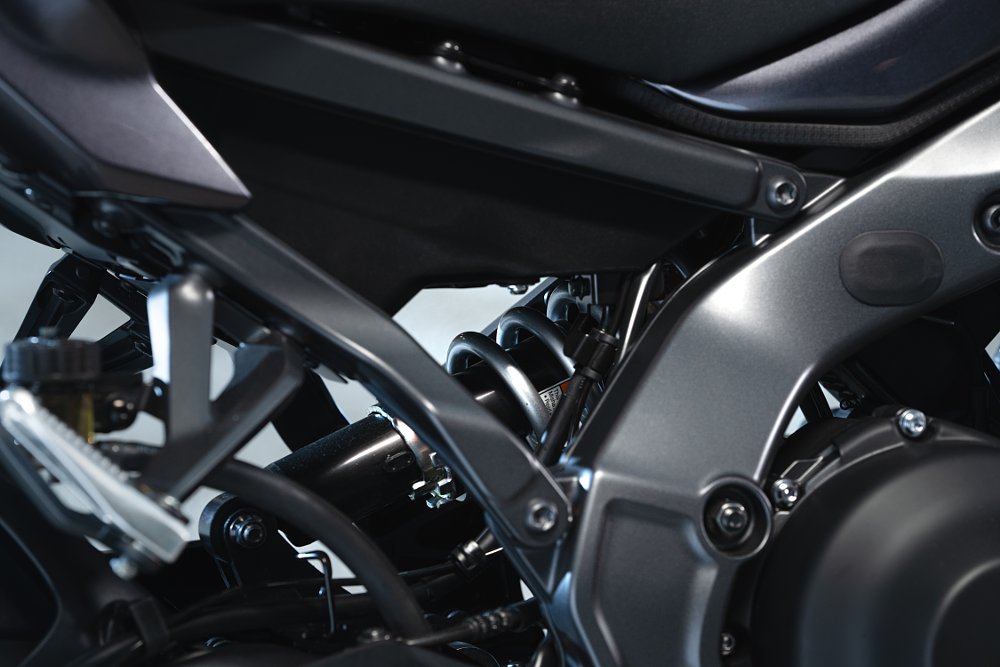
There’s less dive at the front end and less squat in the rear. Overall, the certified hooligan machine is just more even-keeled. For example, when testing the previous-gen 09, I often wheelied out of one particular corner along my testing route. With a sharp rise at the corner exit, hard acceleration lofted the front wheel into the air without fail. Time after time, I couldn’t replicate those results on the 2024 model. I’ll be clear. That’s a good thing. I don’t want to wheelie there, and the MT abides.
The updated suspension isn’t without its drawbacks, however. The shock performs well over garden-variety bumps and potholes, but its limits are evident on rougher roads. Weighing in at 180 pounds (in full gear and after a big lunch), I might be a little light for Yamaha’s intended audience. At least I hope so, as the shock sent the jolt of sharp-edged bumps, g-outs, and railroad tracks right up through my coccyx. On several occasions, the impact catapulted my behind out of the seat for a one-alligator count.
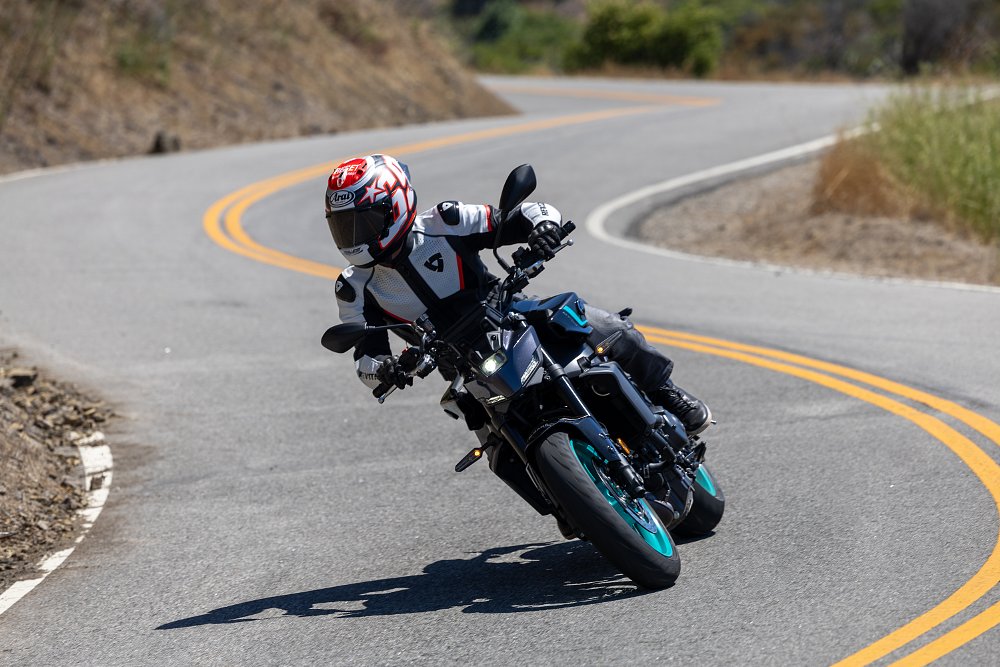
Tech talk
The 2021 marked a technological leap for the MT-09. The 2024 model follows in those footsteps with a fully reworked tech suite. The 3.5-inch dash grows to a 5.5-inch TFT. Yamaha packs four different layouts into that larger display, all of which display trip meters, range, temperatures (ambient and coolant), and fuel gauge. Users can opt for pre-set ride modes (Sport, Street, and Rain) or adjust the settings (traction control, wheelie control, throttle response, etc.) to their liking in the two custom modes. Implementing those changes is easier than ever with the model’s revamped UI.
The MT-09 changes user interfaces about as often as Rupert Murdoch changes wives, but this one’s a keeper (the UI, not Rupey’s wife). I couldn’t say the same for the last generation’s system. The scroll wheel was clunky and the display was small, basic, and dated. Navigating the new interface feels instinctive, thanks to the left switchgear’s d-pad and well-organized menus. It works like a well oiled machine. It isn’t without its quirks, though.

The new rocker-style turn signal switch is a prime example. I’m used to the old-fashioned toggle blinkers. I’m used to the left switch turning on the left blinker, no matter how many times I hit it. It’s not supposed to turn it off too. That’s the cancel button’s job. Those dual-function buttons left me second-guessing all too often.
"Did I already signal? Hit it again, just in case. (Looks at dash.) Great, I canceled it instead.”
As Zack acknowledged, the new system only “makes you look at the dash more,” as you often need to confirm the blinkers are actually doing what you want them to do. Sure, they have an auto-canceling feature, but that’s not a reason to move away from the efficacy and simplicity of the old toggle switch. Rant over.
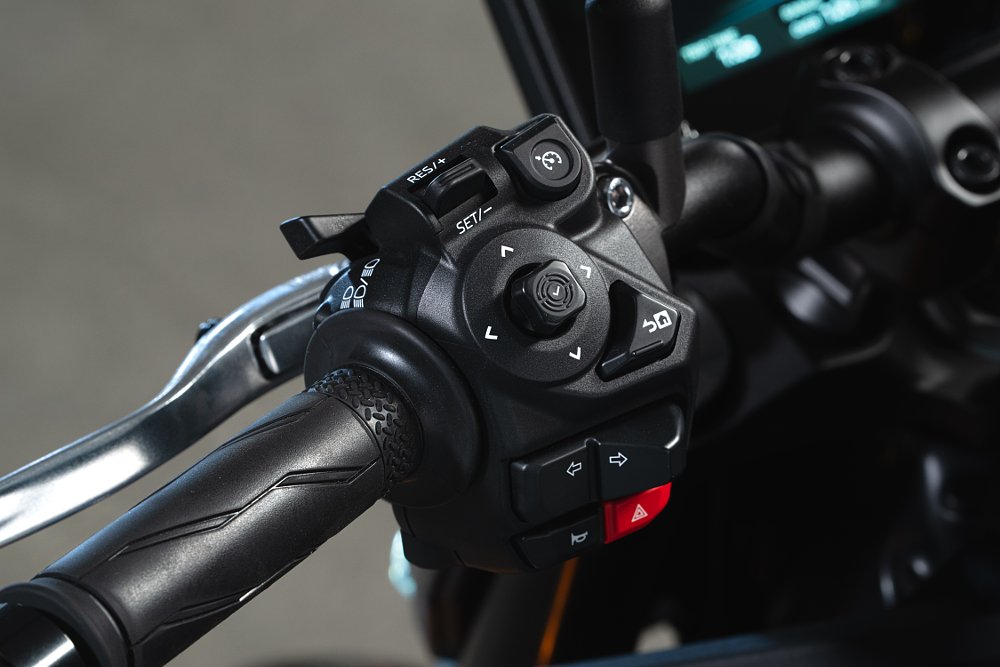
Syncing the MT to Yamaha’s Y-Connect App was equally frustrating. I don’t typically connect my phone to my bike. At some point between downloading the app, pairing my phone, and the Reckoning, I tend to call it quits and just go for a ride. The juice is rarely worth the squeeze. The MT’s system reminded me why.
First, I connected my phone to the system. That was my first mistake, as the interface only interacts with the Y-Connect app. After installing the app on my phone (along with Yamaha’s two other recommended apps), the bike prompted me to wipe my phone from the MT’s saved devices and remove the bike from my phone’s directory. Aiya! Only then was I able to pair my phone to the bike.
After that 15-minute song and dance, it turns out the bike wasn’t mirroring the app’s turn-by-turn navigation anyway. Perfect. Flummoxed and perplexed, I finally gave up the ghost and fed Google Maps directions through my helmet’s comm unit. That process was less complicated and, arguably, more effective.
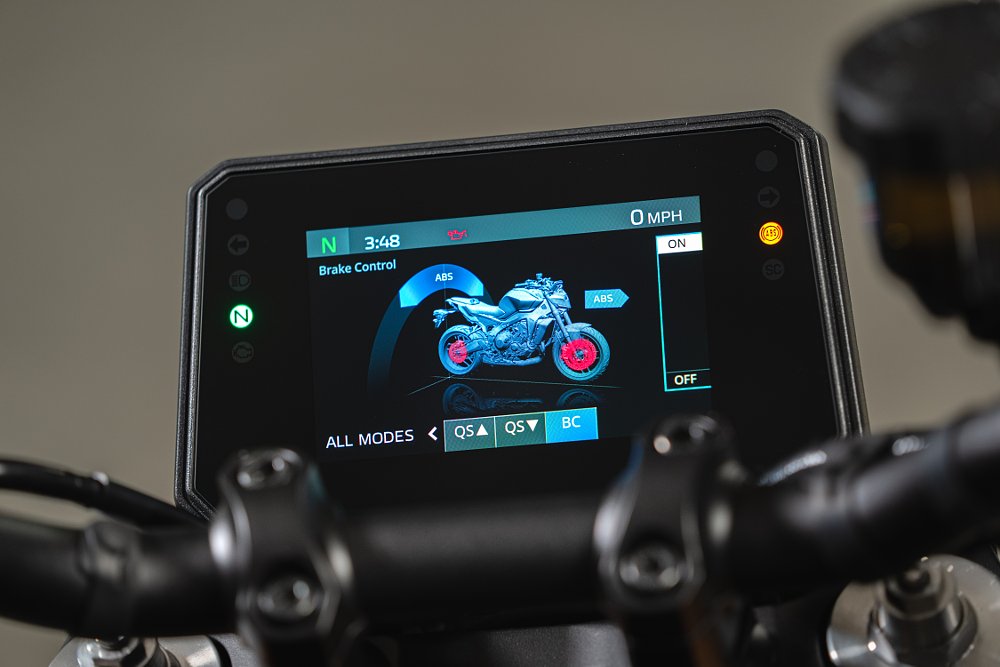
Tech often seemed like the MT-09’s Achilles heel. If it wasn’t the lack of rider aids, it was the lackluster interface. The 2024 model addresses many of those shortcomings. No, it doesn’t perfect the Bluetooth connectivity dance, but it’s largely helpful, otherwise. As a result, the MT feels like a much more refined package this time around.
Aging well
“Your Honor, I’m sorry I pulled dank nooners in that school zone. Sorry I slalomed through rush hour traffic. Sorry I pulled 95 [mph] in a 55 [mph]. It was the bike.”
Get nabbed by the long arm of the law while hooning on the MT-09, and that’s probably what the court transcript reads. Heavy emphasis on probably. The fact of the matter is the middleweight MT makes it easy to do bad things, ahem, fun things. Its patented blend of grin-inducing torque and athletic agility are to blame. Over its decade-long run, it’s just learned to have that fun in a more responsible manner.
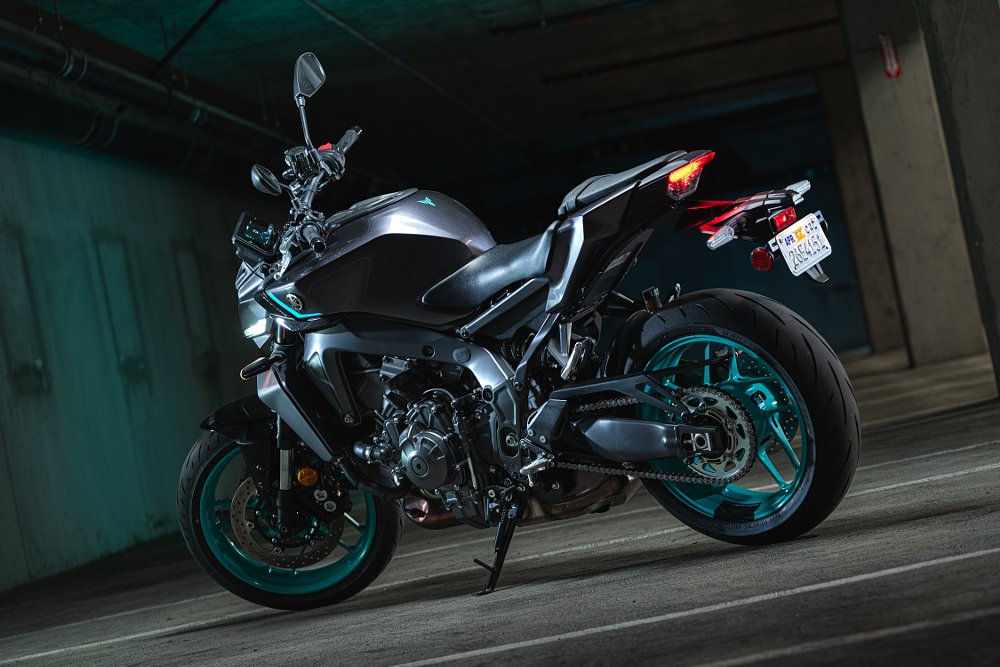
With each new generation, the MT-09 matures. The 2024 edition is no exception. That doesn’t mean it’s too old for one-wheeled antics. It still wheelies on command, just less on its own accord. It still darts through gaps that aren’t there and whips up to 60 mph before you can utter, “Jesus take the handlebar.” The 2024 MT-09 is still fun. It just exists in the space between reckless and responsible, between recidivism and reformation. At this point in the MT-09’s lifespan, that’s a good place to be.
| 2024 Yamaha MT-09 | |
|---|---|
| Price (MSRP) | $10,599 |
| Engine | 890 cc, liquid-cooled, 12-valve, inline triple |
|
Transmission, final drive |
Six-speed, chain |
| Claimed horsepower | 117 @ 10,000 rpm |
| Claimed torque | 68.6 foot-pounds @ 7,000 rpm |
| Frame | Aluminum twin-spar |
| Front suspension | KYB 41 mm fork, adjustable for spring preload, compression, and rebound damping; 5.1 inches of travel |
| Rear suspension | KYB shock, adjustable for spring preload and rebound damping; 4.6 inches of travel |
| Front brake | Dual four-piston calipers, 298 mm discs with ABS |
| Rear brake | Single-piston caliper, 245 mm disc with ABS |
| Rake, trail | 24.7 degrees, 4.3 inches |
| Wheelbase | 56.3 inches |
| Seat height | 32.5 inches |
| Fuel capacity | 3.7 gallons |
| Tires | Bridgestone Battlax Hypersport S23, 120/70ZR17 front, 180/55ZR17 rear |
| Measured weight | 425 pounds |
| Available | Now |
| Warranty | 12 months |
| More info | yamaha.com |

 Membership
Membership









